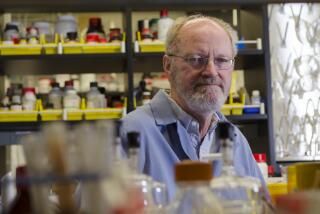PRC Scientist Must Be Economist Too : Chemical Architect Builds Polymers to Order
Hakam Singh is a leading scientist at Products Research & Chemical in Glendale. But his job means also being part economist and part environmentalist.
Singh, a 60-year-old native of India who joined PRC in 1968, is now head of polymer research. Polymers are collections of molecules used to create the sealants, coatings, adhesives and other specialty chemicals that PRC sells.
The job of Singh and other PRC scientists is to decide how to string together various molecules to create a polymer that can then be treated in certain ways to produce a new product. For example, they might need a polymer that, once combined with other chemicals, turns into a coating for an aircraft carrier’s deck, a coating that is durable, slip-resistant and non-rusting.
Singh compared a single polymer molecule to a brick, and said that joining “bricks” in various ways creates different kinds of “buildings,” or polymers.
“I enjoy the challenge of inventing new things, of the demands made by our customers and our marketing people,” Singh said in a recent interview.
New Laws
If PRC’s marketing staff says new environmental laws have created a need for a tougher sealant for fuel storage tanks, Singh goes into the lab and tries to figure out how to come up with the appropriate polymer.
“You can build the most beautiful polymer, but if its price is beyond the reach of any customer, than what’s the use of that polymer?” Singh said. “We cannot use anything which is extremely hazardous” to the environment, he
said, or one that creates “any byproduct that is extremely hazardous.”
Once PRC’s marketing staff identifies the need for a new product, Singh and his staff go to work. The designing process “starts here,” he said, pointing to his turban-covered head, “then we draw.”
Once a polymer is created, it is still “alive chemically,” meaning it can further be combined with other chemicals to produce the finished coating or sealant that PRC sells, he said. Singh and his scientists spend their days adding and subtracting other chemical liquids and gases to the polymer to see whether it gains the strength, elasticity or other properties they’re seeking.
The trouble is, “nature is not that kind and not that straightforward,” Singh said. “You can build a very nice molecule on the drawing board, but then there are side reactions.”
Say, for instance, Singh needs to create a sealant to protect window frames from moisture. Based on the molecular drawings, he might think he has a polymer that can do just that. But once the polymer is tested, he might unexpectedly find it also melts at high temperatures and is thus unacceptable.
Enjoying Freedom
Singh said he prefers working at PRC, rather than at a giant chemical concern such as Dow Chemical or Union Carbide, because he says he has a bigger say in what goes out the door.
“You can implement your ideas more freely in a company where the people know that your ideas are valuable.”
More to Read
Inside the business of entertainment
The Wide Shot brings you news, analysis and insights on everything from streaming wars to production — and what it all means for the future.
You may occasionally receive promotional content from the Los Angeles Times.










